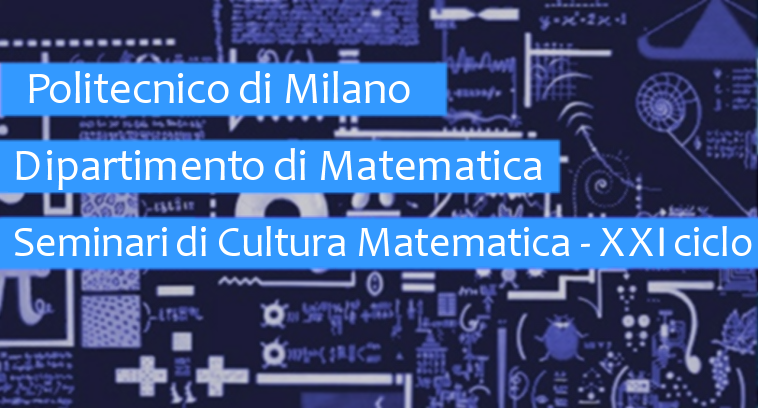Math Seminars

I seminari di Cultura Matematica, nati nel 2001 e quindi con una tradizione molto consolidata, sono cicli di eventi di divulgazione che hanno ospitato, negli anni, sia docenti del Politecnico che docenti esterni appositamente invitati (italiani e stranieri) oltre che noti divulgatori.
I seminari sono liberi e aperti a tutti, e in particolare sono cordialmente e fortemente consigliati a tutti gli studenti di Ingegneria Matematica di tutti gli anni di corso. Per l’anno 2024 si presentano in una veste rinnovata come “Math Seminars: the Human Intelligence”: 4 eventi pomeridiani di attualita’ e divulgazione scientifica (alle 17.30 in presenza e online) curati da Anna Paganoni e Giulio Magli
Locandina dei Math Seminars 2024
Astronome del passato - Una, nessuna o centomila?
Gabriella Bernardi (Giornalista scientifico) Campus Leonardo, via Bonardi 9, Edificio 14 (Nave), aula B21Leggere i dati per progettare le politiche pubbliche per il nuovo millennio: una sfida (im)possibile
Giovanni Azzone - Piercesare Secchi (Politecnico di Milano) Campus Leonardo, via Bonardi 9, aula De DonatoIannis Xenakis: architetto della luce e del suono
Alessandra Capanna (Università La Sapienza Roma) Campus Leonardo, via Bonardi 9, Edificio 14 (Nave), aula B21Oltre il nostro Sistema Solare: alla ricerca di un'altra Terra
Barbara Negri (ASI Agenzia Spaziale Italiana) Campus Leonardo, via Bonardi 9, Edificio 14 (Nave), aula B21Laser superintensi, materiali nanostrutturati, accelerazione di particelle: il ruolo della matematica
Matteo Passoni (Politecnico di Milano) Campus Leonardo, via Bonardi 9, Edificio 14 (Nave), aula B21
Las Meninas di Diego Velasquez: segno, proiezione, riflesso
Luigi Cocchiarella (Politecnico di Milano) Campus Leonardo, via Bonardi 9, Edificio 14 (Nave), aula B21Since it was painted, in 1656, Las Meninas by Diego Rodríguez de Silva y Velázquez, has never stopped astonishing those who face it as spectators, scholars, painters, semiologists, either for its fascinating beauty and imposing size (276 x 318 centimeters), or for its enigmatic set. Quite unusually, we see the painter at work in front of us on a huge canvas, attentively looking into our space and our eyes, together with other depicted characters including the shining Infanta Margarita, aging five at that time, daughter of Felipe IV and Mariana de Austria, the Royal couple appearing reflected in a mirror hung on the rear wall, while the widespread gloom pervading the big space, sometimes ripped by finite irruptions of sharp light further feeds the mysterious atmosphere of the scene, studded by series of big paintings appearing on the high walls and in between the bays.But what actually is the scene, and what does it mean? Art critics and the rich international literature available about Las Meninas have shown, over time, the many levels of meaning and the sophisticated symbolism of the composition, which will be part of our investigation, driving us at a very point of focus: the perspective structure of the representation as a crucial key to understand the enigma.Indeed, as the greatest poetry is intrinsically connected with the sublime use of the grammar, so this art masterpiece seems to be built on and substantiated by the masterly and thoughtful use of projective codes and perceptual refinement, what makes it at the same time a visual representation and a geometrical demonstration. Therefore, our work will mainly focus on the perspective reconstruction of the room, onthe location of the characters in the stage, and on the mirror reflection, in relation to the decentralized position of the sight point, by using modern homological procedures to show the relationships between the apparent perspective image and the conjectured real spatial set, combining drawings, digital models and animations.To make the enigma even more dense and intriguing, the room we see in the painting, which has been identified as the atelier of the painter located in the Galería de Mediodía of the Alcázar de Madrid, the castle of the King of Spain in Madrid, was burned during a devastating fire occurred in the night of Christmas Eve in 1734. The analysis of the painting has also been proposed as an educational case studio in the course of Geometrical Complements of Graphic Representation, an elective course of the Master Program in Architecture at the Politecnico di Milano in the Academic Year 2014/2015.

